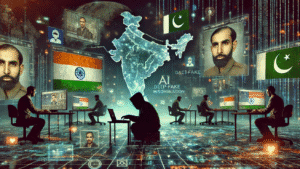Disinformation EXPOSED: 5 Shocking Tactics in Pakistan’s 2025 Playbook Against India
The 2025 India-Pakistan conflict, ignited by the Pahalgam terror attack, exposed a dangerous evolution in warfare—one dominated by disinformation and digital deceit. Pakistan’s strategy blended old propaganda with modern tools like AI, deepfakes, and fake social media profiles to manipulate perception, incite fear, and challenge India’s credibility globally. From the fabricated “capture” of IAF pilot Shivangi Singh to recycled footage passed off as real-time war visuals, the goal was to sow confusion and fracture public trust. Impersonation campaigns and state media further amplified these falsehoods, making it harder to separate fact from fiction.
Experts warned of escalating risks, especially with nuclear tensions looming. India’s response included real-time fact-checking, public awareness drives, and calls for responsible journalism. The conflict emphasized that disinformation is no longer a side tactic—it is central to modern warfare. Combating it demands media literacy, robust detection tools, and international cooperation.

Disinformation EXPOSED: 5 Shocking Tactics in Pakistan’s 2025 Playbook Against India
In modern warfare, truth often drowns in a storm of deception. The 2025 India-Pakistan conflict, triggered by the Pahalgam terror attack, saw not just military clashes but a calculated digital onslaught. As India launched Operation Sindoor, Pakistan’s disinformation machinery weaponized AI, deepfakes, and social media manipulation to distort realities, fuel panic, and sway global opinion. This strategy, rooted in decades of hybrid warfare, now exploits cutting-edge technology to devastating effect.
- The “Shivangi Singh” Hoax: Exploiting National Symbols
A fabricated narrative claiming the capture of IAF pilot Shivangi Singh—a celebrated Rafale jet aviator—spread like wildfire. Pakistani handles circulated old photos and unrelated videos, alleging her detention in Sialkot. Though swiftly debunked, the lie achieved its goal: sowing confusion and denting morale. This tactic mirrored past efforts, such as false claims about Wing Commander Abhinandan in 2019, revealing a pattern of targeting military icons to undermine public trust.
Key Takeaway: Adversaries often hijack national symbols to provoke emotional responses, making fact-checking critical during crises.
- Repurposed Media: Recycling Old Footage as “Evidence”
Pakistan’s digital operatives repackaged unrelated events to fabricate war narratives:
- A Nepali airport farewell video was mislabeled as Indian civilians mourning military losses.
- Chilean wildfire footage falsely depicted Amritsar under attack.
- Protest clips from Nepal and Ludhiana were rebranded as anti-India unrest.
Such content, stripped of context, thrived on platforms where sensationalism overshadows verification.
Why It Works: Visuals evoke visceral reactions. AI tools enable seamless editing, making historical footage appear current.
- Impersonation Campaigns: Fake Profiles, Real Impact
Fake accounts masquerading as Indian officials amplified disinformation:
- A handle posing as Commander Abhilash Tomy shared a Sudan war video, claiming it showed Nagrota airbase’s destruction.
- The account @pinaka_av15, disguised as an Indian colonel, spread panic using misattributed videos of protests and fires.
These profiles borrowed credibility from real figures, exploiting the public’s trust in authority.
Lesson: Verify accounts through official channels before engaging with content.
- Mainstream Media Complicity: State-Backed Amplification
Pakistan’s state-run Associated Press of Pakistan (APP) and military spokespersons propagated blatant falsehoods:
- Fictitious claims of Indian missiles striking Amritsar aimed to incite domestic discord.
- Baseless reports of Pakistani drones over Delhi sought to project military dominance.
Such narratives, echoed by compliant media, lent faux legitimacy to the disinformation ecosystem.
- The Anatomy of a Digital Offensive
Cybersecurity experts like Gagan Jain identified coordinated tactics:
- Hashtag Manipulation: #IndianFalseFlag trended with 14,000+ posts, blaming India for “staging” the Pahalgam attack.
- AI-Generated Content: Deepfakes morphed mourning women into “dancing” civilians, while fake arrest videos targeted PM Modi.
- Psychological Warfare: Revived hoaxes like the “Dance of Hillary” virus preyed on pre-existing fears of cyberattacks.
Expert Insight: Lt Gen Rajendra Nimbhorkar (Retd) stressed that such campaigns aim to “erode trust and inflame passions,” risking escalation in nuclear-adjacent tensions.
Countermeasures: Vigilance in the Age of AI
- Official Fact-Checking: India’s PIB Fact Check and MIB teams debunked lies in real-time.
- Public Awareness: Citizens were urged to cross-verify through trusted sources.
- Media Accountability: Retired Navy spokesperson Capt. DK Sharma emphasized responsible reporting, cautioning against “misguided missile” journalism.
Conclusion: Navigating the Disinformation Battlefield
Pakistan’s playbook—a blend of old propaganda and AI-driven innovation—highlights the dual-front nature of modern conflict. For democracies, the challenge lies in balancing transparency with security, fostering media literacy, and developing agile counter-disinformation frameworks. As technology evolves, so must defenses, ensuring truth isn’t the first casualty in tomorrow’s wars.
Call to Action:
- For Media: Prioritize verification over virality.
- For Citizens: Approach sensational content with skepticism.
- For Governments: Invest in AI-detection tools and international cooperation to curb digital warfare.
The 2025 conflict underscores a chilling reality: in the digital age, disinformation is as potent as any missile.
You must be logged in to post a comment.